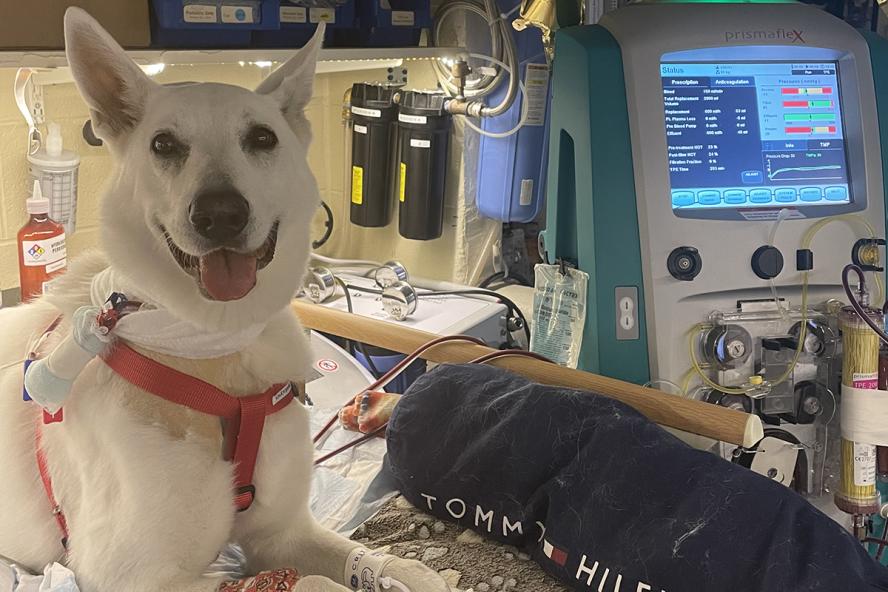-
About
- Leadership & Faculty
- News & Events
-
Academics
- Graduate
- Advanced Clinical Training
- Continuing Education
-
Student Life
- Graduate Programs
-
Research
-
Hospitals & Clinics
- Emergency Care
-
Community Outreach
- Volunteer
Saving Lives of Intoxicated Dogs
Cummings School researchers lead collaborative effort to publish two studies in successful treatment of dogs with NSAID intoxication

Drs. Emmanuelle Butty (she/her) and Mary Labato, V83, of the Cummings School of Veterinary Medicine at Tufts University, have collaborated with colleagues from five other veterinary universities and hospitals to publish two articles in the Journal of Veterinary Internal Medicine (JVIM), examining the effectiveness in the treatment of dogs with non-steroidal anti-inflammatory drug (NSAID) intoxication.
Labato is a veterinary internist at the Henry and Lois Foster Hospital for Small Animals and Cummings School’s Anne Engen and Belle Professor in Clinical Nephrology,
Butty, a clinical assistant professor in the Department of Clinical Sciences, served as lead author of “Outcomes of nonsteroidal anti-inflammatory drug toxicosis treated with therapeutic plasma exchange in 62 dogs,” published by JVIM in September 2022.
The study treated 62 dogs at five veterinary facilities from 2015 to 2020 for NSAID intoxication with therapeutic plasma exchange (TPE), which saved the lives of 98.4% of the canines. It concluded that “when TPE is available and time frame is appropriate, this extracorporeal therapy should be considered for the management of NSAID overdose.”
The second study, titled “Outcomes of 434 dogs with non-steroidal anti-inflammatory drug toxicosis treated with fluid therapy, lipid emulsion, or therapeutic plasma exchange,” was published in December 2022. It analyzed the effectiveness of NSAID intoxication treatments administered to 434 dogs at five veterinary facilities from 2015 to 2020. It concluded that intravenous administration of lipid emulsion and TPE should be considered in the management of severe NSAID toxicosis. The overall survival rate of the canines treated was 99%.
“It’s quite new to have these options for extracorporeal therapies for intoxication and we don’t have a lot of data in the literature,” Butty explains. “These studies share that this type of therapies can save lives, especially for severe intoxications, and this is something that veterinarians should consider and present to the patient’s owner as an option, if the patient is within a good time to respond well to the treatment.
“The treatment of toxicities, and especially NSAID, is a race against the clock before significant damage can be done to the bodies and we have a very small window of time to act. This study provides evidence that these therapies are efficient in saving lives in the cases of severe intoxication.”
According to Butty, there is no antidote for NSAID intoxication and extracorporeal therapies are the only way to remove the toxin. Without them, however, intoxicated animals can have a chance to survive with co-management of treatment options, even if the ingested toxin has caused considerable damage to a patient.
“There are now new modalities to treat intoxication, especially NSAID,” says Butty. “We now have a new type of carbon filter that attracts this type of molecule, so when the blood flows through this filter, the NSAID is strongly attached to the protein, but it prefers the carbon instead of the protein in the blood. So that’s how we shift and pull out all the toxins attached to the protein into the filter, removing the toxin.”
According to Butty, the primary advantage of this procedure is that extra blood product is not required. “This new and safer type of treatment started to be developed after the therapeutic plasma exchange, so that will probably be the next chapter here. Research is continuing as we try to improve what we can do for our patients.”
The best way to avoid a life-threatening situation for dogs is to properly store all medications.
“It’s so difficult for an owner to go through a pet’s treatment for intoxication and I hope they learn from it because a dog could get into this medication again. It doesn’t learn. We need to make sure they can’t access anything that is potentially dangerous to eat.”
Department:
Foster Hospital for Small Animals